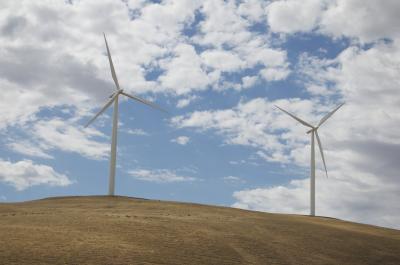Worldwide installations of solar and wind power has skyrocketed. Since 2009, the heyday of government subsidies, global solar photovoltaic installations have increased about 40 percent a year on average, and the installed capacity of wind turbines has doubled.
There's just one problem. It hasn't appeared to help much. No one wants wind turbines near their homes and the cost to create infrastruture in remote areas means the turbines wouldn't evenpay for themselves before they would need to be replaced. Solar panels have startling drops in efficiency after just a few weeks. Countries in Europe are pulling the plug on subsidies and another giant solar panel manufacturer in China has gone bankrupt.
Stanford researchers say that wind energy is not as bad as it seems. They created a metric which includes the "energetic cost" of manufacturing batteries and other storage technologies for the electrical grid to see whether renewable energy supplies, such as wind power and solar photovoltaics, produce enough energy to fuel both their own growth and the growth of the necessary energy storage industry.
"Whenever you build a new technology, you have to invest a large amount of energy up front," said Michael Dale, a research associate at Stanford. "Studies show that wind turbines and solar photovoltaic installations now produce more energy than they consume. The question is, how much additional grid-scale storage can the wind and solar industries afford and still remain net energy providers to the electrical grid?"
Writing in Energy&Environmental Science, Dale and colleagues say that, from an energetic perspective, while solar power can only afford about 24 hours of energy storage the wind sector can afford enough to provide more than three days of uninterrupted power. The reason is because it takes more energy to manufacture solar panels than wind turbines.
Any time you use virtual metrics, the numbers will look a little fuzzy, and energetic cost does not escape unscathed. Utilities will need to pay people and they need to deal with intense regulation that restricts their abilities to function as a business unless costs are subsidized.
Everyone would like to have cleaner energy but Californians, as an example, pay 50 percent more in utility bills to cover the high cost of alternative energy subsidy schemes. Right now, solar panels are subsidized and then utilities are forced to buy any excess at the same cost they sell it, which means rich people who can afford panels get rebates and have their bills further reduced while poor people have to incur the cost of utility employees and maintenance.
The wind installations just inland from Stanford look like a good deal when it comes to energetic cost, but when it comes to real money they are $15 billion in the red.

Credit: Charles Barnhart/Global Climate and Energy Project (GCEP)
Wind and solar farms provide emissions-free energy, but only generate electricity when the wind blows or the sun shines - which means if they are going to be more than a gimmick we will need storage. But batteries have not improved in decades, as Prius owners discover, and the current electrical grid is not in the storage business.
The authors considered a variety of storage technologies for the grid, including batteries and geologic systems, such as pumped hydroelectric storage and found that, for the wind industry, the findings were favorable.
"Wind technologies generate far more energy than they consume," Dale said. "Our study showed that wind actually produces enough surplus electricity to support up to 72 hours of either battery or geologic storage. This suggests that the industry could deploy enough storage to cope with three-day lulls in wind, common to many weather systems, and still provide net electricity to society."
Net electricity is, of course, not the correct metric, unless we want only rich people to have electricity.
The results using energetic costs were even good for onshore wind turbines. "We found that onshore wind backed by three days of geologic storage can support annual growth rates of 100 percent – in other words, double in size each year – and still maintain an energy surplus," he said.
Other costs
The Stanford team's primary focus was on the energetic cost of deploying storage on wind and solar farms. The researchers did not calculate how much energy would be required to build and replace grid-scale batteries every few years, nor did they consider the financial cost of building and installing large storage systems on the grid.
"People often ask, is storage a good or bad solution for intermittent renewable energy?" Benson said. "That question turns out to be way too simplistic. It's neither good nor bad. Although grid-scale storage of wind power might not be cost effective compared to buying power from the grid, it is energetically affordable, even with the wind industry growing at a double-digit pace."






Comments